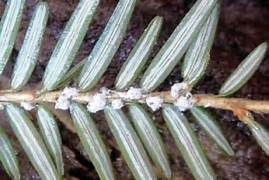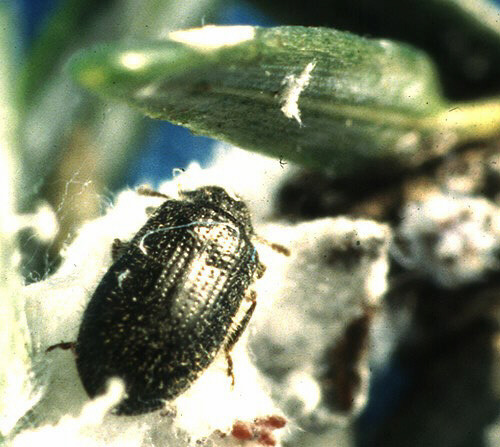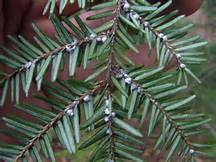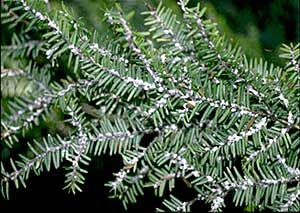Hemlock Woolly Adelgid - Life Cycle
In North America, hemlock
woolly adelgid is parthenogenetic (only females occur, reproducing
without males) and produces two generations a year. One, the sistens, is
wingless, hatches in late spring, overwinters, and survives about nine
months. The other, the progrediens, hatches in early spring, is
comprised of both wingless and winged (sexupara) offspring, and survives
for about three months. Sexupara fly from hemlock in search of a species
of spruce (Picea) on which to deposit eggs (Fig. 3). However, a suitable
species of spruce is not present in North America, so this portion of
the populatin dies before sexual reproduction occurs. The lifecycle of
HWA promotes a rapid increase in population (Fig. 3). Shortly after the
sistens eggs hatch, the first instar nymphs relocate to the bases of
needles and immediately become dormant (aestivation). As temperatures
cool in the fall, the sistens nymphs break dormancy and begin to feed
and develop throughout the winter when temperatures are moderate. Adults
begin to lay eggs in March – earlier in southern states or during mild
winters. During late fall and early spring, few natural enemies are
active and hemlocks produce abundant quantities of sugar and amino
acids, which provide good nutrition in the twigs where adelgids feed.
This results in a high level of egg production. A single sistens female
typically lays between 50 and 175 eggs Hemlock woolly adelgid annual
life cycle on hemlock in North America. Figure 3. Hemlock woolly adelgid
annual life cycle on hemlock in North America. (as many as 300 eggs have
been observed) (McClure et al. 2001). The progrediens generation lays
fewer eggs, typically between 25 and 125, but offspring mature rapidly
after hatching. Egg production in early spring and again in early summer
has a multiplier effect on the population, which if unchecked by natural
enemies or other factors results in exponential population growth.
Hemlock woolly adelgid feeding on Carolina hemlock and Canadian hemlock
causes the needles to desiccate (dry up) and the buds to stop growing.
Within a few months of heavy infestation, the tree looks grayish green,
needles begin to drop off, and little or no new foliage is produced.
Foliage loss and dieback of major limbs become visible in 2 to 4 years.
An infested hemlock may survive for many years, but its foliage is
usually sparse at the branch tips and very top of the crown. Weakened
trees often succumb to diseases and attacks from other insects, such as
elongate hemlock scale and are easily broken and thrown by wind.






